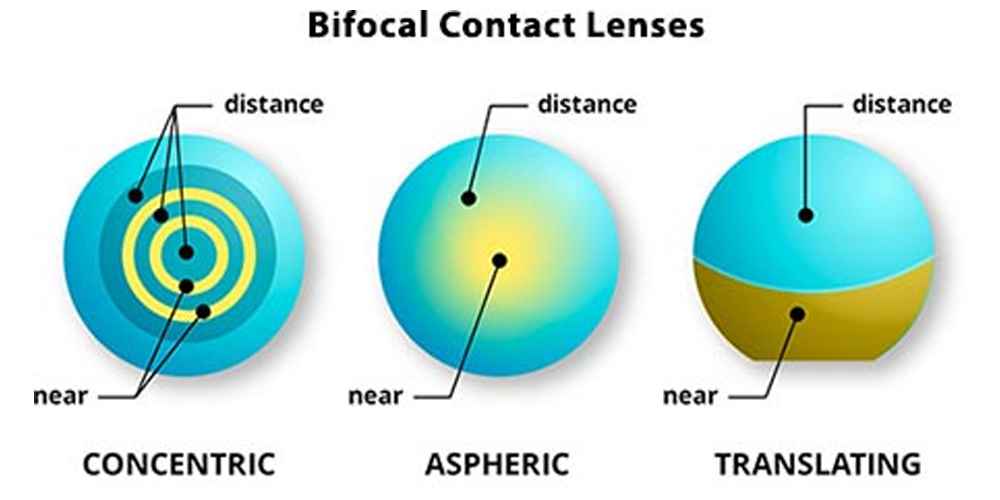Before we start indulging in bifocal contact lenses, their benefits, and their types, let’s take a step back to explore the conditions for which the doctor might prescribe them for you.
What is Presbyopia?
The clear lens in your eye is the flexible part responsible for focusing light on the retina for precise and proper vision. This lens starts getting rigid as you age, making it hard for you to see up close when you cross the 40-years-old limit, a condition called Presbyopia.
This condition can interfere with daily tasks, it causes headaches and eye strain, and it can’t be reversed. However, there are several options to correct it using Eyeglasses, Contact Lenses, or Surgery in some cases.
What is Myopia?
It is an eye focusing disorder, also known as Nearsightedness, where you can see close objects perfectly, but distant objects seem blurry.
It is a refractive disorder, meaning the eye can no longer bend light properly and focuses it in front of the retina instead of on it. It causes headaches and eye strain and can interfere with daily life. Imagine having to squint each time you need to clear your vision or take a decent look at a slightly distant object!
Bifocal Contact Lenses: Two solutions in one technology:
Now that we took a closer look at the conditions mentioned above. Let’s take things to a higher level and acknowledge the struggle people with both eye conditions face! If you are one of them, we realize how hard it can be to go about your daily life.
Since surgery might be frightening for you, and eyeglasses can come in the way of your active lifestyle, or they are simply a disturbance to your style, then bifocal contact lenses are your most suitable choice.
Bifocal Contact Lenses are manufactured in different designs, including Soft material for your comfort, Gas permeable material for better oxygen transmissibility, and Hybrid material combining the two.
In a nutshell, they are the most convenient and efficient solution for both near and distant vision troubles.
Types of Bifocal Contact Lenses:

Bifocal contact lenses offer dual prescription; one for near vision and the other for distant vision, and they are categorized into two main types:
Segmented Design:
This design is also called Translating or Alternating Design. These lenses have two areas of function; the upper region of the lens is responsible for correcting distant vision, and the lower one is accountable for correcting near vision. The transition between the two can be disturbing for a while, but don’t worry; you will quickly adapt to how the lenses work.
Simultaneous Design:
These lenses allow you to correct both near and distant vision simultaneously. Your eyes might need some time to adapt and learn how to focus on the thing you are looking at. This category is also divided into two groups depending on the design:
- Concentric Design: the center of such lenses often holds the distance vision power and is surrounded by rings of near and distant powers. There are actual boundaries between the regions that might cause some difficulty adapting to how the lenses work.
- Aspheric Design: These lenses’ power moves gradually between near and distant vision correction with no actual boundary. Therefore, your vision system needs to adapt and select the right lens power to see things clearly.
How to choose the right Bifocal Contact Lenses type?
First and foremost, consult an eye doctor for a diagnosis of the condition and a treatment plan. In the case of Presbyopia, the doctor depends on your pupil size and near prescription to determine which type of Bifocal Contact Lenses is fit. For mild to moderate Presbyopia, the doctor is more likely to go with the Aspheric type. As for Advanced Presbyopia, Concentric or Segmented contacts are best.
Pros and Cons for Bifocal Contact Lenses:
Most people prefer Bifocal Contacts on Eyeglasses in terms of use and maintenance, and they reported having high visual acuity for both near and distant vision. However, it might be hard at first to adjust and switch between prescriptions, and the lenses can cause a problem with glares at night and some eye strain. Plus, Bifocal Contact Lenses are usually more expensive than single-vision contacts and require a longer fitting process.
Read More: Contact Lenses VS Glasses: Which is Better?
Don’t forget to visit MetroBrazil Store for high-quality contact lenses.
